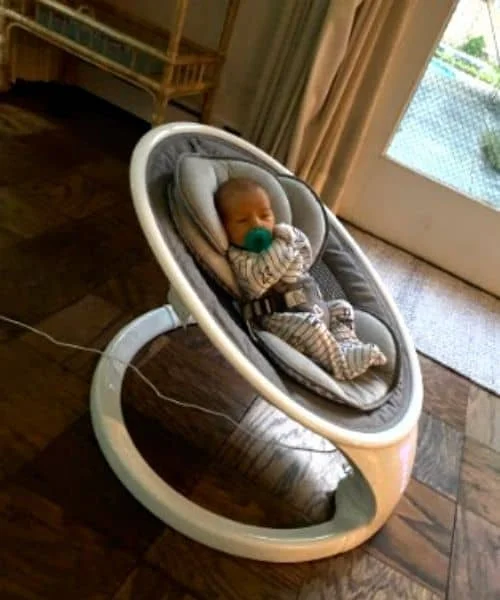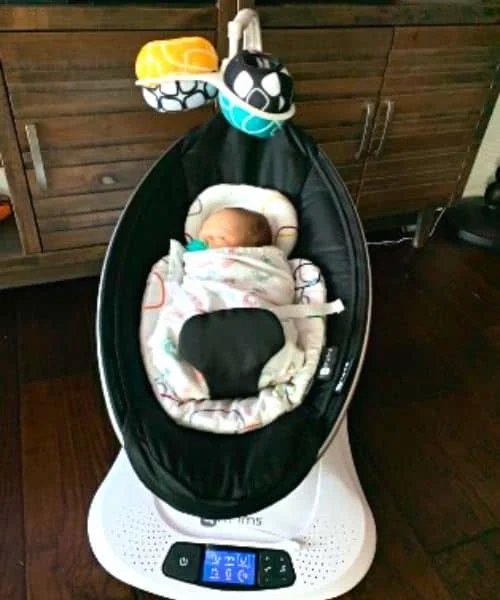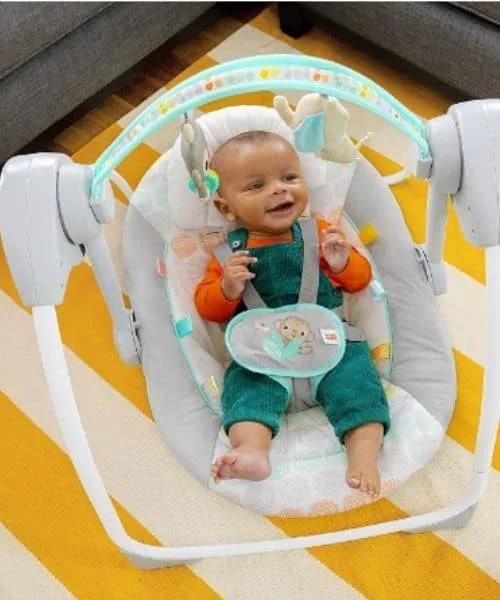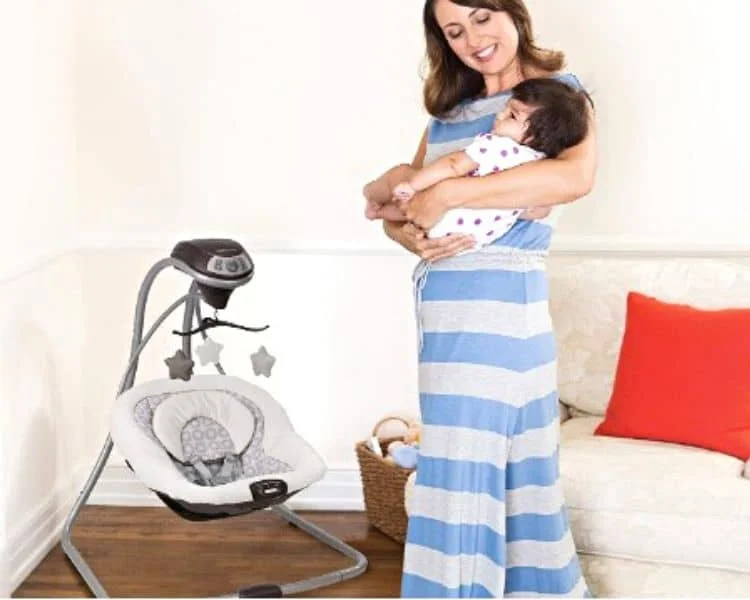Last Updated on July 17, 2023
When it comes to baby swings, there are a lot of different opinions on what age is the best time to start using one. Some parents wait until their baby is a little older, while others start using them as soon as their baby is born. So, what is the right answer? Well, it depends on your baby and your own personal preferences.
In general, most swings can be used from birth until your child reaches around 24 months old or around 30 pounds. After that point, the swing may no longer be comfortable or safe for your child to use. The American Academy Of Pediatrics (AAP) recommends that parents utilize the most reclined setting on baby swings for babies under four months old.
In this blog post, we will discuss when to start and stop using a baby swing, How long baby can stay in a swing, the pros and cons of using a baby swing at different ages, and a lot more insight on the baby swing. So, keep reading!
- When to start using baby swings?
- When do babies stop liking swings?
- When to stop using baby swings?
- Can babies sleep in a swing?
- How long can baby stay in a swing?
- What are the basics of baby swing safety?
- Tips for using a baby swing to calm your infant
- Benefits of Baby Swings
- Cons of Baby Swings
- Safety Precautions For Baby Swings
- What to Look For in a Baby Swing?
- Baby Swing FAQs
- Final Verdict
When to start using baby swings?

Baby swings can be used from birth until your child reaches a certain weight limit of 25 and 35 pounds. Some baby swings can accommodate up to 40 pounds, but this is rare.
The average weight limit for most models of baby swings is between 25 and 35 pounds. If your child exceeds the weight limit for their particular model of swing, they will need to be transitioned to a different type of product.
As your child grows, you may find that they no longer fit in their swing as comfortably as they did when they were younger. This is perfectly normal!
As your child begins to grow and develop, they will need more space to move around in order to stay comfortable. You may want to consider transitioning your child to a different type of product, such as a bouncer seat or activity center, when this happens.
Related Read: Is swinging baby too fast harmful
When do babies stop liking swings?
Most babies outgrow their swings by 9-10 months old. However, every baby is different. Some babies may love swings well into their toddler years, while others may prefer other types of activities or toys by the time they reach one year old.
If your baby seems to be losing interest in the swing, it’s probably best to try something else. There are plenty of other ways like activity centers, and bouncers to keep your little one entertained and happy!
When to stop using baby swings?
Once your baby can sit up on their own and has developed some head control, it’s time to stop using the swing. Babies who are old enough to sit up on their own are also often able to get out of the swing by themselves, which can be dangerous. If your baby seems frustrated or unhappy in the swing, it might be time to stop using it as well.
At three months of age, it is best for a baby to stop using the swing. But at an earlier age, even though your baby’s legs are now strong enough to hold them upright for a longer period of time, placing them on a flat surface for napping or putting them down while they’re still sleepy puts them at risk of Sudden Infant Death Syndrome(SIDS).
If you’re not sure when to stop using the swing, talk to your child’s doctor for guidance.
Can babies sleep in a swing?

Every baby is individual to others. Some babies sleep very well in swings, while others do not. However, the baby won’t be safe sleeping in a swing. Infants haven’t developed the strength in their necks to support their heads. Babies of any age can fall asleep anywhere, so they might seek refuge in the swing. If they’re not in a reclined position, they may drop their head and obstruct their oxygen supply.
If you think your baby might enjoy sleeping in a swing, it is certainly worth a try. Once the baby falls asleep, it’s best to move them to a crib or a firm flat sleeping surface. Just be sure to monitor your baby closely to make sure they are safe and comfortable.
How long can baby stay in a swing?
The time of the baby spends in the swing should be limited. Most babies enjoy spending time in a swing, but it is important to make sure that they are not in the swing for too long.
It is generally recommended that babies be in the swing for no more than 30 minutes at a time.
The author of “What to Expect the First Year”, Heidi Murkoff recommends, “After 30 minutes, it should be removing your baby from the swing and limiting the number of 30-minute sessions per day”.
This will help to ensure that they do not become overstimulated or uncomfortable. If you notice that your baby is starting to get fussy, it is best to take them out of the swing and let them explore other activities.
What are the basics of baby swing safety?
There are a few basic things you need to keep in mind when using a baby swing:
– Always use the swing with supervision. Never leave your baby unattended in the swing.
– Make sure the swing is on a level surface and that the seat is securely locked in place.
– Never put anything in the swing with your babies, such as toys or blankets.
– Don’t use the swing if it appears to be damaged in any way.
-Always use the provided safety that came with the swing.
– Don’t allow your baby to be “pushed” in the swing by older children. Even if your baby appears happy, don’t let them swing for more than 30 minutes at a time.
By following these simple safety tips, you can help ensure that your baby enjoys a safe and fun experience in their swing.
Tips for using a baby swing to calm your infant

If your infant is fussy or colicky, a baby swing can be a lifesaver. Here are some tips for using a baby swing to calm your infant:
– Put the swing on a level surface. You don’t want it tipping over while your baby is in it.
– Secure the straps. Make sure the straps are tight enough so your baby can’t wiggle out of them.
– Know the maximum weights allowed.
– Put a blanket over the top. This will help to muffle any noise the swing makes and make it more cozy for your baby.
– Make sure newborns are positioned as far back as possible.
– Start at a slow speed. You can always increase the speed if needed, but you don’t want to startle your baby with a fast swing.
– Don’t leave your baby unattended. Never leave your baby in the swing unsupervised. Even if they seem to be sleeping peacefully, they could roll over and get stuck or hurt themselves.
Benefits of Baby Swings
Baby swings become part and parcel of parents of newborn children. Here are the reasons:
- It is much like a mother’s womb.
- An infant swing can be a great way to soothe and entertain your little one.
- For parents, swings can provide much-needed breaks throughout the day.
- It can help to ease the colic of babies.
- It helps keep your baby around you.
- The back-and-forth motion of a swing can also help babies develop important gross motor skills such as head control, trunk control, and reaching. These skills are important for future development in activities such as sitting up, crawling, and walking.
- Swings provide a gentle rocking motion to help soothe and calm babies. This movement can also help stimulate the vestibular system, which is responsible for balance and coordination.
Cons of Baby Swings
The limitations of baby swings are-
- The Effect of Poverty on a Child’s Development. Babies require time alone to explore their surroundings and have the opportunity to do so.
- There is a risk of Sudden Infant Death Syndrome(SIDS) and risk of suffocation.
- The effect of insufficient sleep.
- While maintaining all the cautions, there is an increased risk of injury and less safety due to reduced safety.
Safety Precautions For Baby Swings
- Make sure the swing is secure and won’t easily fall over or collapse.
- Use the safety straps that come with the swing, so your baby doesn’t fall out.
- Remain mobile phones, toys and other accessories away from your baby.
- Don’t use it if your baby no longer fits securely, so check to see whether they have outgrown the manufacturer’s weight restrictions.
- Ensure not to place the baby’s swing on an elevated surface.
- For babies four months and under, always use the most reclined position on the swing.
What to Look For in a Baby Swing?

When you are shopping for a swing for your beloved baby, there are several factors that you need to keep in mind. The following is a list of some of the most important things to look for when choosing a baby swing:
Safety features:
Any good baby swing should have safety features built into it. Look for swings that have brakes or locks to keep the swing from moving when you don’t want it to. And check that there are no sharp edges.
Ease of use:
You should be able to set up and take down the swing easily. It should also be easy to clean.
Comfort:
The baby seat should be comfortable for your baby to sit in. Look for swings with padded seats and headrests.
Durability:
The baby swing should be made from durable materials that will last for years.
Style:
There are many different styles of baby swings available. Choose one that fits your personal taste and the style of your home.
Multiple movement system:
In a swing, there are different types of movement features, such as, Side to Side, Front to back, vibrating and bouncing.
Guidelines:
Check the weight and age limit guidelines.
Baby Swing FAQs
Final Verdict
So, what age is good for baby swing? As long as your baby is under 25 to 35 pounds, you may use a baby swing until they reach that age.
That being said, there are a few things to keep in mind when choosing a baby swing for your child. First, it’s important to make sure that the swing can be adjusted to fit your baby’s height. You also want to choose a swing with various speeds and sounds so your baby can stay entertained.
Finally, you should consider how easy the swing is to clean before making your final decision.
When it comes to finding the perfect baby swing for your child, it’s important to keep their individual needs in mind. With so many different options on the market, you should be able to find a product that will work well for your family.
Resources:
- https://www.verywellfamily.com/how-to-use-a-baby-swing-5114389
- https://www.verywellfamily.com/can-babies-sleep-in-a-baby-swing-5100896
- https://www.cnet.com/health/parenting/how-to-break-your-babys-habit-of-sleeping-in-a-swing/
- https://www.babycenter.com/baby/crying-colic/how-long-can-i-leave-my-baby-in-a-swing_10351368
- https://www.consumerreports.org/cro/news/2008/06/baby-swing-safety/index.htm

Amy A. Vincent is a Certified Pediatric Sleep Consultant and a mother of three beautiful children. She helps parents transition their babies from swing sleep to safe, independent sleep. She is passionate about helping parents teach their children the skills needed to become good sleepers and aims to make the process as easy and stress-free as possible. Read more
